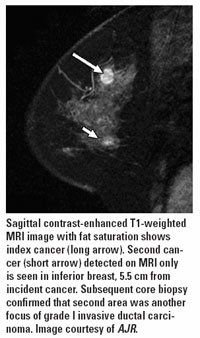Breast MRI before radiation zeroes in on multifocal disease
Potential candidates for accelerated partial breast irradiation (APBI) may benefit from pretreatment MRI to ensure no cancer is missed, according to a study conducted by a multidisciplinary group of researchers.
ABSTRACT: MRI found cancer sites other than the index tumor in 38% of patients, according to study.
Potential candidates for accelerated partial breast irradiation (APBI) may benefit from pretreatment MRI to ensure no cancer is missed, according to a study conducted by a multidisciplinary group of researchers.

Breast MRI reveals mammographically occult cancer foci in 38% of cases, stated Juan Godinez, MD, and his colleagues. Dr. Godinez is from the department of radiation oncology at Brigham and Women’s Hospital and the Dana-Farber Cancer Institute, both in Boston.
After lumpectomy, doctors are likely to recommend whole-breast radiation to ensure no tumor cells are missed. APBI in selected patients at low risk for local recurrence is “safe and well tolerated, but long-term recurrences and cosmetic results are not yet available,” the group wrote (Am J Roentgen 191:272-277, 2008).
This retrospective study included 79 women, aged 29 to 75, all eligible for breast-conserving surgery and APBI. Of the 79 patients, 80 additional lesions were seen in the ipsilateral breasts. Of the additional lesions, 57% were found in the same quadrant and the remaining 42% in a diff erent quadrant. Twenty-eight lesions were biopsied by core needle biopsy, 32 lesions were surgically excised and 20 were followed up with MRI at 6 months.
From the 28 core biopsies, 17 showed additional malignancy and 11 were benign. Of the 32 surgical excisions, 28 were malignant and four were benign.
Of the 20 lesions followed up by MRI two patients underwent core needle biopsy with benign results. The remaining 18 lesions were deemed stable.

The surgical plan for 30 of the 60 patients who underwent core needle or surgical biopsy was changed to a wider excision including mastectomy, according to the researchers. For 19 of the 30 patients with a changed treatment plan, pathology of the surgical biopsy detected 28 additional cancer foci. MRI detected 33 additional foci in the patients. Based on clinical, imaging, and pathology results, 62% of the women were considered eligible for APBI with T1-T2, N0, M0 breast cancer. MRI detected 126 abnormalities, including the index tumors.
Additional cancer sites, other than the index tumors, were found in 38% of patients. Of those patients, 10% had additional cancer in a different quadrant from the index tumor.
“Breast MRI may provide benefit by potentially refining criteria for selecting patients for treatment with accelerated irradiation, with its ability to detect multifocality and additional tumor sites away from the lumpectomy bed,” the researchers wrote.
“Left non-irradiated, occult cancer may give rise to a recurrence that manifests years later,” he said. Thus, he added, MRI “should be part of the work-up for those patients who meet eligibility criteria for [A]PBI and are interested in less than whole breast irradiation.”
The researchers said physical examination and conventional imaging with mammography and sonography are insufficient to exclude additional occult lesions, whereas MRI is more revealing.
Click here and here to read the Vantage Points.